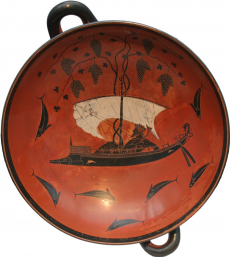
Email: EllaTournes@bexleygs.co.uk
Total Article : 45
About Me:Sixth form student currently studying English Literature, Drama and Theatre Studies, Classical Civilisation and History.

The Amasis Painter's 'Ovoid Lekythos (Weaving) Vase', can be described as stagnant and a little lifeless in places, due to the lack of activity and movement in its narrative technique – very different to Exekias, who depicts certain moments very effectively, adding to the fluidity of the piece. The drapery in other artists of the black-figure movement often seems undeveloped and ill-fitting, with either no elaborate gestures (like in the 'Francois Vase'), or, on the other hand, over-elaborate gestures (the in the Amasis Painter's 'Wedding' vase). These vases also have an issue with depth and realism – torsion is often incorrect and seems unnatural, like in the 'Gorgon Painter', if not, characters appear very two-dimensional and only appear in profile or full-frontal, like the 'Francois Vase'.
It could, however, be argued that Exekias was not one of the finest artists of his time, in comparison to the other artists of his time. Side B of the 'Achilles and Ajax' vase is certainly not as developed as Side A (the side that depicts the two heroes). Exekias seemed to struggle with torsion in exactly the same way his contemporaries did – Castor's head faces a completely opposite direction to his body, appearing unrealistic, making it less effective as a vase. The face of Dionysus in the Dionysus vase is very unrealistic - there is no real expression and there is very little detail. Dionysus is also very out of proportion with the scene – he is too large for the boat, and his surrounding appear out of proportion. This detracts from the realism of the piece.
Other artists could be argued to be just as good as Exekias. The Gorgon Painter, and Sophocles both used the round nature of their vases extremely effectively, in a way that Exekias didn’t - they used it to give a full narrative, to make the vase into a full cohesive story, rather than just depicting one moment. These artists use things like colour (depicting women in white and men in black) in a cleverer way than Exekias, as they gave it meaning.
In my opinion, Exekias work is the best work, aesthetically and narratively, from the black-figure period, making him the finest artist from that period. However, it is important to consider that he was one of the later artists from this period – the 'Ajax and Achilles' could've been created more than seventy years after the 'Gorgon Painter' vase. It is therefore important to consider that techniques and forms would've developed throughout that time to help Exekias make his vases more detailed and realistic and therefore to look better. Exekias himself could be said to be representative of the development of the black-figure period as a whole, and how the form, narrative, realism, movement and perspective changed throughout time, with the help of the artists that made up the movement.
Source: https://en.wikipedia.org/wiki/File:Exekias_Dionysos_Staatliche_Antikensammlungen_2044.jpg

0 Comment:
Be the first one to comment on this article.